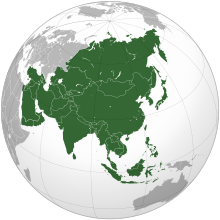
Pic Courtesy: Wikipedia
Asia
The largest continent with 30% of land mass (17.21 Million Square miles) and 60% of the world population (4.6 Billion) spread across about 48 countries.
The three biggest economies of the continent (China, India, and Japan) are among the top 5 economies of the world.
Five Asian countries feature in the list of top 10 militaries of the world (China, India, Japan, Korea, and Turkey), and ten Asian countries feature in the top 20.
The continent is generally divided into 5 regions (East, Central, West, south, and southwest).
Conflict and War
“If you want peace, be prepared for war”
– Julius Caesar
Conflict arises due to a perceived threat to own needs and interests.
Conflicts are a part of life and are prevalent among all living organisms.
Unresolved conflicts can cause violence, aggression, and fights.
In the context of nations, conflicts if not resolved could lead to a war.
War is generally intentional, declared, widespread, long-duration, and armed conflict between nations and states. It is one of the instruments for settling disputes.
History is replete with conflicts, tensions, rifts, violence, skirmishes, battles, and wars.
“Object of war is peace”
– Aristotle
Conflicts and wars can be largely classified as:-
-
- Induced and escalated by global strategic dynamics (e.g. world wars I and II).
-
- Inherited ones (e.g. Asian border wars due to colonial legacies).
-
- Arising out of internal issues and fault lines but affecting others (e.g. Bangladesh liberation war of 1971).
-
- Due to non-state actors (e.g. Taliban and IS etc.).
Statistical Analysis
SIPRI data on arms transfer, treaties, and wars reveals the following:-
-
- Wars are as old as 2500 BC.
-
- Recent times (19th and 20th centuries) have seen about 3000 wars.
-
- Post world war, the trend shows a gradual reduction.
-
- Asia has seen a much higher rate than the global average.
-
- Some of the regional countries involved in wars include China, India, Pakistan, Afghanistan, Vietnam, Syria, Iran, Iraq, and Israel.
A high number of wars in the Asian region makes one wonder if it is circumstantial or by design.
Some of the existing hot spots in the region include:-
-
- South China Sea.
- India, Pakistan, and China.
- Korean peninsula.
- USA and China rivalry.
The majority of hot spots center on China with direct or indirect involvement.
Changing Nature of War
Generally, the duration and extent are reduced (world wars to local wars to skirmishes.
The wars are becoming high-tech with advanced platforms, weapons, and systems.
Wars are no longer limited to the military domain. All tools of state-craft (diplomacy, information, military, and Economy) are actively involved.
Newer domains of warfare include cyber, space, electronic, and information besides earlier ones i.e. land, sea, air, and nuclear.
Grey zone warfare is the order of the day wherein anything and everything can be used as a weapon.
The use of terrorism, asymmetric warfare, piracy, and non-traditional warfare has become a norm.
The absence of war does not mean peace and peace does not mean the absence of hostile activities.
Militaries alone do not go to war, Entire nation goes to war.
Lessons from Recent Wars
Conflict situations demand a whole-of-nation approach.
Self-Reliance is essential not only in defence production but in a much broader perspective.
One has to fight its own wars, yet multilateralism and collective security are relevant.
Interoperability and alliance are helpful even in dealing with situations arising out of grey zone hostile activities.
Deterrence (Military and nuclear) works.
Sanctions do not prevent violent aggression but need to be catered for.
National security needs to be addressed holistically (including energy, food technology, etc.).
Concluding Thoughts
Wars are fought over resources and economic control. Differences of opinion about ideology, religion, and way of governance are mere excuses.
Power flows from the barrel of the gun resting on the economic tripod.
Change is the only constant. Adapt or perish.
Learn (even from your enemies) continuously and be prepared accordingly.
THINK IT OVER
Maximum wars have been fought in the Asian region.
The region has been exploited and its riches have been plundered.
Still, Asia is rising.
Will the coming century belong to Asia or the opportunity will be missed by infighting?
Suggestions and value additions are most welcome
For regular updates, please register here
References and credits
To all the online sites and channels.
Disclaimer:
Information and data included in the blog are for educational & non-commercial purposes only and have been carefully adapted, excerpted, or edited from sources deemed reliable and accurate. All copyrighted material belongs to respective owners and is provided only for purposes of wider dissemination.

That last question is absolutely important! Well put-together, Chhotu!
Thanks Rags